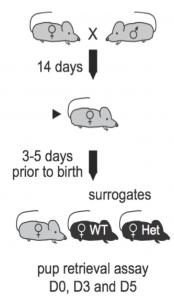Background:
We use learned maternal behavior as a complex and rich read-out for social interactions. The modified maternal behavior paradigm is a wonderful model to study adult experience-dependent learning

Breeding schema for learned maternal behavior paradigm
and plasticity. This complex behavior involves mother, pups and naïve virgin females that act as surrogates (allo-parenting) and help care for the pups. The 3 adults and the pups are co-housed for over an entire week. We used a pup retrieval behavior test to check for maternal behavior features in the surrogates.
Our first study using this model was done at Cold Spring Harbor Laboratory in collaboration with Dr. Stephen Shea (published; bioRxiv version). We found atypical experience-dependent plasticity via perineuronal nets and parvalbumin+ GABAergic neurons in the auditory cortex of MECP2-deficient female mice led to their inefficient pup gathering behavior. Specifically,
- SurHet (Mecp2-heterozygous surrogate females) were inefficient gatherers
- SurHet became better at gathering with genetic and pharmacological manipulation targeting GABAergic neurons
- SurHet expressed higher numbers of high-intensity perineuronal nets, extracellular matrix structures that are thought to inhibit plasticity, in the auditory cortex.
- MECP2 expression in the auditory cortex is essential for efficient gathering in wild type mice
Relevance and Significance:
Rett Syndrome primarily affects girls and women. To date, most studies are done in male mouse models. Our hypothesis suggests that relevant behavioral contexts are essential to understand how MECP2 deficiency causes Rett Syndrome. We chose learned maternal behavior as this is a complex, ethologically-relevant assay that uses different senses (smell, sounds, touch etc) and motor actions (searching for pups, carrying pups to nest etc) in a complex social situation ( 2 virgin mice, 1 mother and up to 8 pups) in a single home cage. We learn how mice navigate their environment and each other; that informs us how MECP2 might play a role in this process.Since girls affected with Rett Syndrome process sensory and motor information in an atypical manner, and have lost acquired vocalizations in early development (which is important for social communication) we believe this behavioral assay lets us analyze multiple affected processes in all its complexity.
Our current questions are:
- How do mice use vocalizations to communicate with each other during this social behavior?
- What brain regions and circuits facilitate integration of auditory information and movement in this social behavior? (how do we do this?)
Current methods:
- Perform audio and video recordings during pup retrieval behavior.
- Record and analyze home cage behaviors (24hrs a day, for the duration of the maternal behavior) with minimal human interference, to reduce stress to the animals and to compare what adaptations occur when stressed.
Our preliminary results suggest (1) extensive and complex vocalizations during pup retrieval behavior between pups and adults; and (2) adult female mice exhibit rich repertoire of vocalizations in certain contexts.
Mother retrieving a pup to the nest, under one microphone. High pitch sounds are emitted by the pup being carried to the nest.
Collaborators:
Dr. Kevin Reilly
Dr. Devin Casenhiser